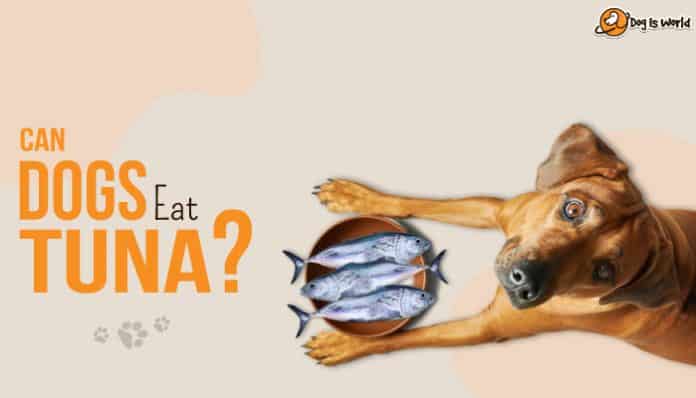Have you ever pondered the question: Can dogs eat tuna? Or are you thinking of feeding tuna to your dog?
If you answered yes, you’ve come to the right spot. We’ve done the research, so all you have to do is sit down and read the article.
Dogs live on land, but fish dwell in water, therefore there is a significant difference between the two creatures. So it must be a generic question, one thinks of.
Humans commonly ingest fish such as tuna or salmon; but because a dog’s anatomy differs from that of humans, feeding your pet dog tuna in large quantities is unhealthy.
Sadly, this is not a Dr. Suess novel, so brace yourself for a bumpy journey.
Table of Contents
Can Dogs Eat Tuna?

If you’ve been wondering if your dog can eat tuna, the response is “yes,” but with a word of caution: only in small quantities.
Tuna should not be included in your dog’s meals on a frequent basis.
Heavy metals and pollutants enter saltwater and pollute it, therefore tuna fish will ingest more metals in their system as long as they are in the ocean.
Since saltwater contains many of these substances that enter the fish’s body, they remain in the system, and in turn, enter the body of your dog when they are consumed.
Fish, particularly larger ones like tuna, have a lot of mercury stored up in their tissue, which can cause mercury poisoning and be extremely harmful to your dog.
Despite being a fantastic source of protein and omega fatty acids, it is typically a good idea to keep the pet’s tuna eating to a minimum.
Can Dogs Eat Raw Tuna?

Okay, I’m quite sure everyone enjoys eating sushi. Am I right? or am I right?
But that isn’t always the case for your dog.
Raw tuna fish can contain more quantities of mercury than cooked or canned tuna.
Despite the fact that fish is an excellent source of protein, it should be fed with caution.
Yes, dogs have powerful stomach acids that aid in food digestion and destroy bacteria, but raw tuna contains intestinal parasites that can still wind up in the stomach when consumed.
Feeding raw tuna fish to your dog might be dangerous if intestinal parasites enter your dog’s stomach.
If you have to feed raw tuna to your canine, do so with extreme caution and keep a check on his health
Because skipjack and albacore tuna have the lowest mercury levels, these fish are a good choice.
If you want to learn more about fish and which ones can be fed to your canine, check this article on seafood dogs can eat.
Feeding Tuna To Your Dog

Now that we’ve discussed “Can dogs eat tuna fish” and “Can dogs eat raw tuna fish”, let’s talk about how to feed tuna to your canine
Canned Tuna

Just like the tunafish sandwich said, I’ve got a feeling we’re not in cans-us anymore.
When considering whether to give tuna, there is always the choice of giving canned tuna.
Keep in mind the tuna you give your canine is canned in water or brine rather than sunflower oil, which can trouble his tummy.
Don’t give your dog any canned tuna with spices or flavorings, as these can make him very sick.
Never feed your dog any vegetable condiments like tomato, onion, or garlic, as these can be toxic.
When feeding canned tuna, use smaller tuna fishes since larger tuna fishes contain higher mercury residues in their bodies.
Another thing to consider when feeding canned tuna to your dog is the canned tuna sold in stores is extremely salty which is not healthy for dogs.
When it comes to dogs, canned tuna with a lot of salt can cause dehydration, excessive water intake, and internal health problems.
Tuna Grilled, Baked, and Cooked

Cooked tuna should be fed to your dog, and raw tuna should be avoided at all costs if possible.
Cooking, grilling, and baking tuna are some of the ways you can offer tuna to your dog, and canned tuna is always an option.
The tuna fish’s fins, tails, bones, and head should not be fed to your dog since they might cause choking and internal bleeding.
Remember to feed the tuna in reasonable portions, even if it is cooked. And if this is your dog’s first time eating tuna, feed a very little portion to see if your doggy likes it. If he does, you can continue feeding him.
How Much Tuna Can You Feed Your Dog?

As previously said, the amount of tuna that can be offered to your dog should be very little to moderate, but here is a more thorough breakdown:
Only a spoonful of tuna or less should be provided to your dog since more can cause mercury buildup in the canine’s tissue.
You can restrict the amount of tuna you provide based on your dog’s weight.
Larger dogs are more accustomed to eating tuna than smaller kinds of dogs
You should never feed your canine more than a tablespoon of tuna in a week. A can of tuna is sufficient for a month and should never exceed that.
It is not recommended to feed tuna to a puppy.
When giving tuna to your dog, make sure to keep an eye on the health of your canine.
The Benefits Of Tuna For Dogs

Well, now that we’ve gone through how much tuna can be fed to your canine.
Bloop Bloop
Let’s read about some health benefits of feeding tuna to your canine
Let’s get that guppy love!!
Tuna fish is high in protein and can be beneficial to your dog’s health.
The high protein content and Omega-3 fatty acids can help to keep cardiovascular issues at bay.
Omega-3 fatty acids can also maintain your dog’s hair and keep the fur healthy and glossy.
Tuna is also high in B vitamins, vitamin D, potassium, magnesium, iodine, choline, and phosphorus.
All these minerals and vitamins are healthy for your canine.
A tuna is also an excellent option since it helps with a sensitive stomach if your dog is experiencing such problems.
Tuna may be a decent alternative, but keep in mind that tuna should only be fed in small amounts.
If you want to administer minerals and vitamins in the canines diet, read this article to know more about important vitamins and minerals for your canine but don’t forget to check your veterinarian before giving your dog any medications.
Signs Of Mercury Poisoning:

If you’ve fed tuna or fish to your pet, there’s nothing to worry about, but you should keep an eye out for these signs of discomfort in your dog
Among the symptoms of mercury toxicity in dogs are:
- Vomiting blood
- Itchy Skin
- Coordination failure
- Loss of sensation in the paws
- Diarrhea or Stool that is watery or bloody
- Kidney disease manifests itself as the inability to pee or abdominal edema.
- Hair loss
- Blindness
If your canine shows any of these symptoms after consuming tuna or any other species of fish, take your canine to the vet immediately.
If you want to read more about it, you can check out this blog mercury toxicity in dogs.
Now that you know about your canine’s relation with tuna eating, let’s go through the primary point about the things you’ve read– We know that the main concern about feeding your dog tuna is the mercury content in the fish.
Can My Dog Be Allergic To Tuna?

Although it is uncommon for dogs to be allergic to fish, it is possible.
Because many dogs are allergic to other protein sources such as beef and chicken, fish is becoming a more popular protein source in dog foods.
Since feeding fish to dogs is becoming more common, an increasing number of dogs are being diagnosed with fish allergies.
Some of the symptoms that may appear after your dog consumes fish, including tuna fish, are as follows:
- Skin itch
- Vomiting
- Diarrhea
- Fur thinning
Along with more serious symptoms such as anaphylaxis, hives, and swelling.
So, if you see any of these symptoms and suspect that your dog is allergic to tuna, you should contact your veterinarian as soon as possible.
Feeding tuna to your dog in large quantities can be harmful, so feeding small quantities such as one tablespoon is the right amount.
Another thing to remember is that you should never feed your dog more than a tablespoon of tuna per week, and a can of tuna is enough for a month and should never be exceeded.
When it comes to feeding, raw tuna fish can contain more mercury than cooked or canned tuna.
Heavy metals and pollutants enter saltwater and pollute it, so tuna fish will absorb more metals in their system as long as they are in the ocean.
Finally, while tuna is a terrific source of protein, minerals, and vitamins for your dog; it should be fed in small amounts and in moderation.
And a word of caution to pet parents who also have cats at home: make sure your dog is not ingesting your feline’s food, as cat food contains fish which can be harmful to your dog.
Frequently Asked Question
Dogs can eat tuna, but only in little amounts. In a week, no more than a teaspoon should be provided to your dog. Tuna is an excellent source of protein for your dog's diet but be careful not to overfeed your canine.
If you're wondering if your dog can eat canned tuna, the answer is yes.
Canned tuna, preferably small tuna fish, is recommended because larger ones contain more mercury, which can be harmful to your dog.
If you intend to offer tuna to your dog, do it only once every four weeks or once a month, and only in tiny and moderate portions.
To be more specific, a tablespoon of tuna should be plenty for your canine, since more can be hazardous and result in mercury accumulation in your canine's stomach.
So you have some tuna sandwich leftovers that you can feed to your pet, yeah?
Mayo is normally not toxic to your pet, so as long as the tuna is consumed in moderation, it is Okay. So, sure, you can give your dog tuna mayo.
No, your dog isn't allowed to eat tuna salad. The high mercury levels in the fish are harmful to your pet and should be avoided at all costs.
Tuna sushi is not something you can give your dog. Sushi is raw fish, and raw fishes contain a lot of mercury stored in their bodies, which is harmful to your dog and can cause mercury poisoning.
A dog can eat a tuna casserole if the tuna is human-grade and is safe to consume. The term "human-grade" on a label indicates that a product and its constituents meet the legally-recognized edible standard.
Woof Woof!
Greeting dog lovers and pet parents,
This article covered all about “Can dogs eat Tuna?”
Hope this was informative and answered all your questions regarding fish and canines
Don’t forget to share or save this article if you’re planning to feed your dog tuna or fishes
We also have socials that we update regularly!!
Check out our Instagram and Youtube












